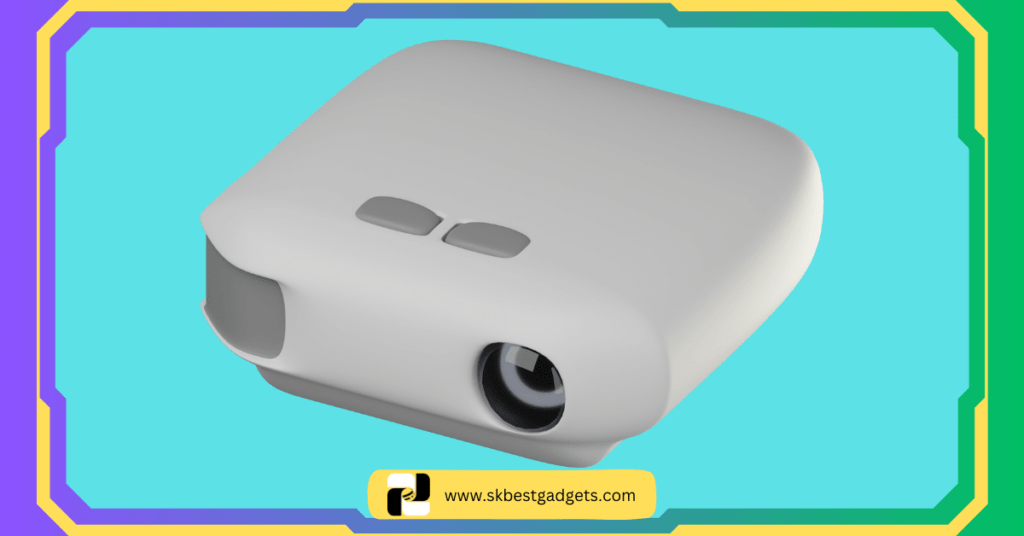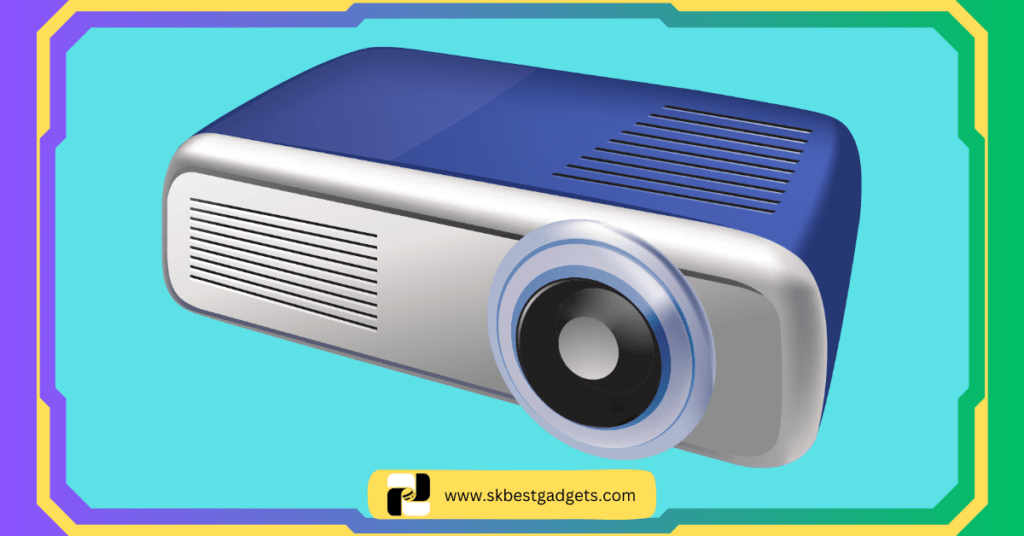What are Projectors? Unlocking the 5 Secrets of Projectors: What You Didn’t Know!

A projector is an optical tool designed to display images, including dynamic visuals, onto a surface, typically a projection screen. Projectors serve multiple purposes, such as:
- Watching movies and TV shows
- Playing games
- Giving presentations
- Teaching classes
- Holding meetings
- Watching live events
- Home Entertainment
There are many different types of projectors available, each with its strengths and weaknesses. Some of the factors to consider when choosing a projector include:
- The size of the image you want to project
- The brightness of the projector
- The resolution of the projector
- The type of input sources you want to use
- The price of the projector
In this article, we will discuss everything you need to know about what are projectors, from the basics of how they work to the different types of projectors available and how to choose the right one for your needs.
We will also provide tips on how to use a projector properly and how to get the most out of your projector.
So whether you are a first-time projector buyer or you are looking to upgrade your existing projector, this article is for you.
Key Takeaways
- Projectors are versatile, serving diverse needs from entertainment to presentations.
- Consider brightness, resolution, and price when choosing the right projector.
- Proper setup is crucial for optimal projector performance and image quality.
- Explore projector features like zoom, focus, and keystone correction.
- Projectors offer portability and cost-effectiveness for large-screen displays.
- Collaboration and engaging presentations are benefits of using projectors.
- Projector viewing angles influence image clarity; choose seating wisely.
- Top projector brands include BenQ, JVC, and Sony; research thoroughly.
- Buy projectors online, at local electronics stores, or at specialized dealers.
- Projector prices range from $100 to $5,000; match features to budget.
What are projectors and where are they used?
A projector is an optical device designed to project images, including moving ones, onto a surface, typically a projection screen.
The fundamental mechanism of most projectors involves transmitting light through a small transparent lens. However, more recent advancements have introduced projectors that utilize lasers for direct image projection.
These versatile devices find applications across various domains:
Business Presentations: Projectors are widely employed in the corporate world for delivering business presentations. They facilitate the display of slides, videos, and other visual content. Additionally, they can project computer screens, enabling multiple individuals to view the same information simultaneously.
Education: Within the realm of education, projectors serve as invaluable tools. Teachers employ them to project images, videos, and presentations onto a sizable screen. This fosters more engaging and interactive lessons, enhancing the learning experience for students.
Home Entertainment: In the realm of home entertainment, projectors offer an alternative to conventional television sets. They allow users to watch movies, and TV shows, and play video games on a larger screen, resulting in a more immersive viewing experience than traditional TVs.

Museums and Art Galleries: Projectors play a pivotal role in museums and art galleries. They are used to display artwork, maps, and other exhibits. Furthermore, projectors enable the creation of interactive experiences for museum and gallery visitors, enhancing the overall visitor experience.
Events: Projectors are frequently employed at various events, such as weddings, conferences, and trade shows. Their utility extends to displaying presentations, videos, and other visual content, thus aiding in effective communication and engagement at such gatherings.
Gaming: Enthusiastic gamers utilize projectors to elevate their gaming experience. Projectors provide a larger screen, intensifying the immersion and enjoyment of video games.
While the specific features and capabilities of projectors may differ based on the model and intended use, all projectors fundamentally adhere to the same principle of projecting images onto a surface.
These devices have become indispensable tools across diverse sectors, enriching how we communicate, educate, and entertain in the modern world.
Are there any types of projectors?
Projectors come in various types, each with its own set of features and advantages. Here, we’ll explore the most common types:

DLP Projectors: These projectors employ a digital micromirror device (DMD) to produce images. The DMD consists of tiny mirrors that can be individually toggled on or off to create the desired image. DLP projectors are celebrated for their ability to deliver bright images with sharp details.
LCD Projectors: In contrast, LCD projectors use liquid crystal displays (LCDs) to generate images. These displays are composed of tiny cells that can be activated or deactivated to produce the desired image. LCD projectors are renowned for their vibrant colors and wide viewing angles.
LED Projectors: LED projectors utilize light-emitting diodes (LEDs) to create images. LEDs are known for their energy efficiency compared to traditional light sources like halogen bulbs. Additionally, LED projectors boast extended lifespans.
LCOS Projectors: LCOS projectors leverage liquid crystal on silicon (LCOS) displays to produce images. These displays are similar to LCDs but employ silicon instead of glass as the substrate. LCOS projectors are distinguished by their high contrast ratios and rapid response times.
Laser Projectors: The most expensive type, laser projectors use lasers to generate images. They offer the brightest images and longest lifespans among all projector types.
Apart from these primary categories, there are other projector types to consider, such as short-throw projectors, portable projectors, and interactive projectors. Your choice of projector should align with your specific needs and budget.

Now, here’s a handy table summarizing the key features of these projector types:
| Type | Technology | Pros | Cons |
|---|---|---|---|
| DLP | DMD | Bright images, sharp details | Can be noisy |
| LCD | LCD | Vibrant colors, wide viewing angles | Not as bright as DLP projectors |
| LED | LEDs | Energy-efficient, long lifespan | Not as bright as DLP or LCD projectors |
| LCOS | LCOS display | High contrast ratio, fast response time | More expensive than LCD or LED projectors |
| Laser | Lasers | Brightest images, longest lifespan | Most expensive type of projector |
How does a projector work?
First things first, they kick things off by turning on a light source. Think of this as the projector’s “Let there be light” moment.
Next up, they grab an image source like a slide, your computer screen, or a cool movie file. This source goes in front of a lens, and this lens is like the superstar that’s going to focus the light and send it flying onto a screen.
Now, the screen is where the real action happens. It catches all that light and bounces it back at you, forming the image you’re dying to see.
Now, projectors come in two flavors: digital and analog. Digital ones use things like computers or DVD players to dish out images.
They’ve got this nifty chip called a digital micromirror device (DMD) with zillions of tiny mirrors. Each of these little fellas can be turned on or off to create the picture you want. Fancy, right?

Then there are LCD projectors. These bad boys work their magic using liquid crystal displays (LCDs). Picture them as tiny cells that flip on and off to craft your image masterpiece.
Analog projectors are a bit rarer these days. The most familiar face in this gang is the overhead projector. It’s all about shining light through transparency and beaming it onto a screen.
So, in a nutshell, projectors are like magicians with a light bulb and a lens. They’re used for all sorts of cool stuff, from dazzling presentations to epic movie nights and gaming marathons. They’re your all-in-one ticket to visual awesomeness in any setting!
How to use a projector properly?
Using a projector effectively involves several key steps. First and foremost, selecting the right location for your projector is crucial. It should be positioned in a well-lit area, but avoid direct sunlight. Place the screen in front of the projector, ensuring it is at least as large as the desired image.
Next, ensure the image is sharp and clear by adjusting the focus. This can be done by turning the focus ring on the projector. Additionally, rectify any distortion in the image by adjusting the keystone, which can be achieved through the keystone correction buttons on the projector.
Properly managing brightness is essential. Adjust the brightness using the projector’s brightness knob to strike a balance between visibility and avoiding an overly bright display.
Connecting your projector to the source device is the next step. Depending on the source, you’ll need to follow specific connection methods, whether it’s a computer, DVD player, or game console.

After connecting, power on both the projector and the source device. This should result in the image appearing on the screen. It’s advisable to double-check and fine-tune the settings, including image quality, sound, and power consumption, to meet your preferences.
Here are some additional tips to enhance your projector experience:
Controlling Ambient Light: If you’re using the projector in a dark room, consider closing curtains or blinds to eliminate stray light. Conversely, in a well-lit environment, opt for a projector screen designed for bright settings.
Presentation Preparation: When using the projector for presentations, practice your delivery in advance. Familiarize yourself with adjusting projector settings to ensure the best possible image quality during your presentation.
Optimizing for Entertainment: For movie-watching or gaming purposes, take the time to customize settings for a comfortable viewing experience. Adjust brightness, color, and other settings to make the image easy on the eyes during extended periods of use.

where a projector be used?
Projectors find versatile applications across various settings, including:
Business presentations: In corporate environments, projectors are indispensable for showcasing slides, videos, and other visual content during meetings and presentations. They also facilitate the projection of computer screens, enhancing collaborative viewing experiences.
Education: Within the realm of education, projectors are invaluable tools for educators. They enable teachers to project images, videos, and presentations onto a sizable screen, promoting engagement and interactivity among students.
Home entertainment: Projectors offer an enticing home entertainment option, permitting the immersive viewing of movies, TV shows, and video games on a grand scale, surpassing the experience offered by conventional TVs.
Museums and art galleries: Cultural institutions employ projectors to display artwork, maps, and exhibitions, often using them to craft interactive encounters that captivate and educate visitors.

Events: Projectors are frequent fixtures at events such as weddings, conferences, and trade shows, where they are employed to showcase presentations, videos, and various visual content to a larger audience.
Gaming: Gaming enthusiasts harness projectors to elevate their gaming escapades by providing a larger-than-life screen, intensifying the immersive experience.
Outdoors: While projectors can be utilized outdoors, they necessitate a dark environment to deliver optimal image quality.
Indoors: Projectors are adaptable for indoor use across diverse settings, including classrooms, conference rooms, and living spaces, accommodating a wide array of needs and preferences.
The suitability of a projector’s placement hinges on user requirements and the specific environment.
When selecting the ideal location, consider the following factors:
1. Image Size: The projected image’s size hinges on the projector type and the distance between the projector and the screen.
2. Brightness: The image’s brightness is contingent upon the ambient light conditions in the room. Adequate lighting adjustments may be necessary for optimal visibility.

3. Resolution: Image resolution plays a pivotal role in determining the clarity and level of detail within the projection.
4. Projector Features: Some projectors offer features like zoom, focus, and keystone correction. Leveraging these functions can significantly enhance the quality of the projected image.
Ultimately, the choice of where to use a projector and the considerations to bear in mind depend on the specific context and the desired outcome, ensuring that the projector serves its purpose effectively and delivers an exceptional viewing experience.
What are the benefits of a projector?
There are several notable benefits associated with the use of projectors. One of the primary advantages is the ability to display larger images compared to traditional TVs.
This feature makes projectors highly suitable for various applications, including presentations, home entertainment, and scenarios where a substantial screen size is desirable.
Additionally, projectors are known for their portability. Many models are designed to be easily transported and set up, making them an excellent choice for businesses, schools, and organizations that require projectors in multiple locations.

Moreover, projectors often offer a cost-effective solution for creating expansive screens, typically being more budget-friendly than TVs of equivalent size.
In terms of user comfort, projectors have an advantage as they reflect light rather than emit it like TVs. This quality can reduce eye strain, especially during prolonged viewing sessions.
Furthermore, projectors are incredibly versatile tools, accommodating a wide range of purposes such as presentations, movie watching, gaming, and more, making them adaptable to various settings.
Customization is another key benefit of projectors, allowing users to fine-tune settings like brightness, contrast, and resolution to achieve the best possible image quality.
If you’re seeking a solution for generating a large and immersive image, projectors emerge as an excellent choice due to their portability, cost-effectiveness, and adaptability to diverse applications.
Moreover, there are additional advantages to using projectors:
Improved Collaboration: Projectors facilitate enhanced collaboration by enabling multiple individuals to view the same information concurrently. This feature proves invaluable in business meetings, classrooms, and any environment where collaboration is paramount.
More Engaging Presentations: Projectors enhance presentations by enabling presenters to incorporate images, videos, and other visual aids. This not only captures the audience’s attention but also makes the presentation more memorable.

Enhanced Gaming Experience: Gamers can benefit from projectors as they provide a larger screen and a more immersive gaming experience. This feature proves particularly advantageous for video games that require strategy or teamwork.
Projectors offer a multitude of advantages ranging from larger screen sizes to portability, cost-effectiveness, and versatility. These devices enhance user comfort, facilitate customization, and also have the potential to enhance collaboration, presentations, and the gaming experience.
What are the drawbacks of a projector?
Projectors offer an excellent means to project large images, yet they come with several drawbacks. Here are some of the most common issues associated with projectors:
1. Brightness: Projectors perform best in dark environments. Excessive ambient light can lead to a washed-out image.
2. Image Quality: The quality of the projected image can vary depending on the projector model and price. Some projectors produce sharp, clear images, while others yield blurry or pixelated visuals.
3. Maintenance: Projectors demand regular upkeep, including lens cleaning and bulb replacements. This can be inconvenient, especially for infrequently used projectors.
4. Cost: Projectors, particularly high-end models, can be costly. If your projector usage is sporadic, the investment might not be justified.

5. Noise: Certain projectors can be noisy, particularly when their fans run to cool the bulb. This noise can be distracting during presentations or movie screenings.
6. Limited Lifespan: Projector bulbs have a finite lifespan, necessitating periodic replacements. Frequent use can result in substantial replacement expenses.
When contemplating a projector purchase, it’s crucial to carefully consider these pros and cons. If you intend to use the projector in a dark room for presentations or movie viewing, the drawbacks may be manageable. However, if you seek a projector for general use, alternative options should be explored.
In addition to the aforementioned drawbacks, here are some more considerations:
7. Setup Difficulty: Setting up projectors can be challenging, especially for those unfamiliar with the technology. This can pose issues when you need a quick setup or lack technical expertise.
8. Limited Portability: Not all projectors are portable. Some are large and heavy, making transportation difficult. If frequent relocation is necessary, opt for a portable model.
9. Limited Viewing Angles: Projector viewing angles determine the optimal position to see the image. Sitting too far to the side can result in an obscured view, which is problematic when watching with a group.

Projectors offer impressive capabilities for large image projection but come with their share of drawbacks. A careful evaluation of the advantages and disadvantages is essential to determine if a projector is the right solution for your needs.
What are the best brands of a projector?
When it comes to choosing the best brands of projectors to meet your specific needs and budget, several popular and highly regarded options are available in the market. These brands include:
- BenQ: BenQ is known for its quality projectors. Their offerings cater to a diverse range of requirements.
- Epson: Epson is another reputable brand known for its projector lineup, with a focus on image quality and performance.
- Optoma: Optoma offers a variety of projectors, known for their image quality and versatility.
- JVC: JVC is recognized for its high-end projectors, which excel in delivering exceptional image quality.
- Sony: Sony is renowned for its top-of-the-line projectors that offer superior image quality and advanced features.
These brands present a wide array of projectors with varying features and price points.

When selecting a projector, it’s crucial to consider several key factors:
Image Quality: For most users, image quality is paramount. Look for projectors with a high native resolution (such as 1080p or 4K) and a good contrast ratio.
Brightness: The projector’s brightness plays a crucial role in its performance in different lighting conditions. If you intend to use the projector in well-lit rooms, opt for a model with higher brightness.
Features: Some projectors come with additional features like HDR support, gaming modes, and built-in speakers. Assess your needs and preferences to determine which features are important to you.
Price: Projectors are available at a wide range of price points, from budget-friendly options to premium models. It’s advisable to set a budget beforehand to ensure you stay within your financial constraints.
Once you’ve considered these factors, you can begin the process of narrowing down your options to find the ideal projector that aligns with your requirements.

To provide you with some specific recommendations from each of these respected brands:
- BenQ HT2050A: This projector is an excellent value choice priced under $1,000. It offers 1080p image quality, 2,500 lumens of brightness, and an extended lamp life.
- Epson Home Cinema 2250: If you’re looking for a budget-friendly 4K projector, this model offers good image quality and 2,700 lumens of brightness.
- Optoma UHD35: For those seeking high-quality 4K projection with excellent image quality and 3,000 lumens of brightness, the Optoma UHD35 is a strong contender.
- JVC X7000: This high-end projector provides outstanding image quality and 2,200 lumens of brightness for a premium home theater experience.
- Sony VPL-VW325ES: As a top-of-the-line offering, this Sony projector boasts incredible image quality and a high brightness level of 3,840 lumens.
Regardless of the brand you ultimately choose, it’s essential to conduct thorough research and read reviews before making your purchase. This proactive approach will assist you in finding the best projector that aligns perfectly with your specific needs and budget.
Where can I buy the best projector?
There are several options available when it comes to purchasing a projector, whether you prefer shopping online or in physical stores. Here are some of the most popular choices:
Online Retailers: You can explore a wide selection of projectors from various online retailers. Notable online options include Amazon, Best Buy, B&H Photo, and Adorama. Additionally, auction sites like eBay also offer projectors.

Local Electronics Stores: Many local electronics retailers stock projectors as well. Stores like Best Buy, Walmart, and Target are commonly found in various neighborhoods, making it convenient for you to browse and purchase projectors locally.
Specialized Projector Dealers: If you seek a more tailored shopping experience with expert advice, consider visiting specialized projector dealers. These dealers have in-depth knowledge of projectors and can provide personalized assistance that may exceed what you’d receive from larger retail chains.
When deciding where to buy your projector, it’s crucial to factor in your specific needs and budget. If you’re primarily concerned with getting the best price, online retailers might be your preferred choice.
However, if you value in-person support and guidance, local electronics stores or specialized dealers could be more suitable options.
Regardless of where you decide to make your purchase, it’s essential to conduct thorough research and read reviews before finalizing your decision. This diligence will enable you to identify the projector that aligns best with your requirements and budget, ensuring a satisfying purchase experience.

What is the average price for a projector?
The price of a projector can vary depending on its features and specifications. Several factors influence the cost of a projector, including:
Resolution: Projectors come in various resolutions, ranging from 720p to 4K. Higher resolutions produce sharper images but often come with a higher price tag.
Brightness: Projector brightness is measured in lumens. A higher lumen count results in brighter images, which is particularly important for viewing in dark environments.
Contrast ratio: The contrast ratio represents the difference between a projector’s brightest and darkest colors. A higher contrast ratio leads to more vibrant and visually appealing images.
Throw distance: The throw distance refers to the space between the projector and the screen. Shorter throw distances enhance portability, while longer ones are ideal for creating larger images.

Features: Some projectors offer additional features such as built-in speakers, Wi-Fi connectivity, or 3D capabilities, which can increase their price.
On average, projectors typically cost around $500, but they can be found for as low as $100 or as high as $5,000.
Now, let’s explore projectors at different price points:
Budget projectors: These projectors usually feature resolutions of 720p or 1080p and have a brightness of approximately 2,000 lumens.
While they may lack some advanced features, they provide a solid option for basic home entertainment. Examples include the Anker Nebula Capsule II and the ViewSonic M1 Mini.
Mid-range projectors: Mid-range projectors offer resolutions of 1080p or 4K and typically have a brightness rating of around 3,000 lumens.

They deliver superior image quality compared to budget models and may include additional features like built-in speakers or Wi-Fi connectivity. Notable mid-range projectors include the BenQ HT2050A and the Optoma UHD35.
High-end projectors: High-end projectors boast resolutions of 4K or higher and brightness levels of 4,000 lumens or more.
These projectors provide the best image quality and feature sets but come with a higher price point. Examples of high-end projectors include the Epson EH-TW9400 and the Sony VPL-VW695ES.
When selecting a projector, it’s crucial to consider your specific needs and budget. If you require a basic projector for watching movies or TV shows in a dimly lit room, a budget projector will suffice.
However, if you desire superior image quality and additional features, be prepared to invest more in a mid-range or high-end projector.

Important FAQs
What are the primary uses of projectors?
How do projectors work?
What are the main types of projectors available?
Are projectors suitable for outdoor use?
What are the advantages of using projectors over traditional TVs?
What should I consider when choosing a projector?
Can projectors be used in well-lit rooms?
Where can I purchase a projector, and what’s the average price range?
Final Thoughts
In a nutshell, projectors have become pretty darn essential in our day-to-day lives. They’re not just for business presentations anymore; they’re your ticket to leveling up your home entertainment and learning experiences. Projectors bring that “wow” factor that regular screens can’t quite match.
Now that we’ve dived into the different projector types, and their pros and cons, it’s obvious that they’re like Swiss Army knives—useful for all sorts of folks.
Whether you’re a pro trying to wow your clients, a teacher making learning more fun, a movie buff turning your living room into a mini-cinema, or a gamer craving that immersive experience, projectors have got your back.
But here’s the fun part—now it’s your turn! We’re itching to hear your projector tales and wisdom. Ever used one for something epic? Do you have any secret tips up your sleeve? Share your thoughts in the comments.
And hey, if this article rocked your world and you think it could do the same for your pals, don’t hold back. Share it with your crew, your family, heck, even your neighbor’s dog if they’re into projectors. Together, let’s keep uncovering the endless cool stuff projectors bring to our lives!
Read More:
- What is Digital Camera for Photography?
- Highest Rated Dishwasher in 2023 (A Comprehensive Buying Guide)
- How Much Electricity Does a Clothes Dryer Use?
What are Portable Vacuums And How to Use Them? (2023)
Curious about portable vacuums? 🧹🤷♀️ Check out this 2023 article to learn what they are and how to make your cleaning game strong. Keep your space spick and span! ✨🏡







